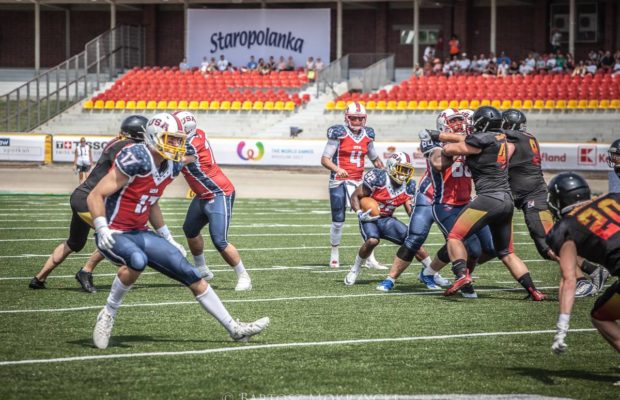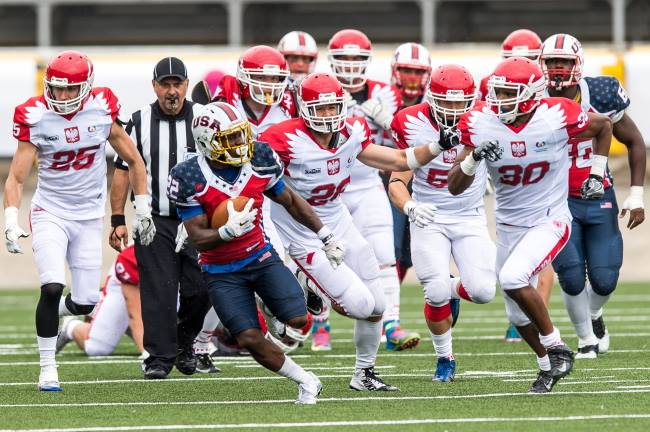Last minute disorganization led to Team USA struggles and 3rd place at 2017 World Games

Visitors to Wrocław, Poland for the American Football games held during The 2017 World Games were treated to a wonderful experience.
The same could not be said for all of the teams competing. In fact, it’s impossible to look back on this international event and shake off the idea that it could have been not just “very good”, but an incredible demonstration of the growing popularity and technical development of football outside the United States.
While the venue, fans and all the aspects surrounding the event were outstanding, football’s participation as an invitational sport at The World Games leaves behind a strange feeling that it had the chance to be much better – mostly because of the fact that, in an American Football tournament, the team that seemed surprisingly out of place was the American team – Team USA.
Favorites in any international football competition, the Americans lost to Germany by 14 to 13 in the opening game of the 2-day tournament and finished in the 3rd place, after beating the host country Poland by the modest score of 14 to 7 in the bronze medal game. This would be fine if those were the results of two hard-fought games with great defensive performances, since low scores not always mean bad football.
Unfortunately, in the age of spread offense, Team USA struggled with timing, couldn’t impose superiority either on passing or running situations and was plagued by a high number of procedure penalties. However, not many know that Team USA wasn’t actually a team until few hours before the kickoff in Wrocław.
A few days prior to the anticipated global event, the U.S. Federation of American Football (USFAF) – the organization that only took over responsibilty for organizing the participation of the United States in the competition in April of this year – lost their funding, literally at the last minute and were unable to provide the transportation promised for virtually all the players who had made the 45-man roster. Consequently, a majority of athletes who had been preparing to compete were not a part of the World Games 2017.
Without a huge effort from the players already in Europe who contacted many of the other imports still in Europe this late in the season, it is fair to assume that the US representation would have withdrawn from competition. That would most likely have forced the tournament to be cancelled, since only four teams were scheduled to compete, with dire consequences for the organizers. So, within a matter of days, Team USA was formed by American imports from all parts of Europe. Although the roster did not meet the 45 man limit, Team USA had enough athletes to make it through the tournament. In the scramble, most of the players were still arriving in Wrocław late on the eve of the first game, with a few not making it to the host city until the morning of the opening game.
With such a troubled path to The World Games 2017, it is understandable that Team USA would not live to the expectations. The poor performance, however, had nothing to do with personnel. On the field, it was clear that the American athletes were individually superior to many of their opponents. However, they seemed to be only a group of great players and not really a team.
The fact that the US had only one brief practice before the semifinal game against Germany was clearly obvious from the lack of sync between quarterback Dustin Hawke Willingham and his receivers and difficulties in pass protection that resulted in 4 interceptions. The Americans also had an unusually high number of procedure penalties and substitution infractions, an understandable consequence of a roster that wasn’t complete until the very morning of the first game.
Even so, the American athletes dominated most of the 1-on-1 situations, especially in man coverage or carrying the ball in space. Players such as the running back Triston McCathern and the receivers Mario Brown and Tyrell Blanks accounted for a big share of the offensive production, more by extending plays with extra effort than by scheme execution. Still, even having to practically draw plays on the dirt, the US team was close to defeat a very disciplined and physical German team, losing by one point in the semifinal. Two days later, the Americans overcame the host Poland by one score, still struggling to channel the individual athletic superiority into the expected consistent, dominant performance.

PHOTO: PAP/MACIEJ KULCZYŃSKI
Team USA fought hard and gave a lot of work to its opponents, so there’s no demerit on Germany’s win or Poland’s close loss. The athletes brought a very high level of football to Wrocław, but the outcome would have clearly been different, had the players had time to get to know each other and the coaches had implemented their offensive, defensive and special teams schemes.
The best of the four matches naturally was the gold medal game, although both Germany and France were forced to focus on the ground game due to a heavy and persistent rain. The French showed tremendous schematic discipline on both sides of the ball and left with the gold, with their first-ever win over Germany after seven meetings.
Wrocław embraced football and The World Games 2017
Off the field, Wrocław pulled all the stops to create a great experience. The city was completely taken over by the event. Athletes and fans from all over the world could be seen on public transportation or walking the streets. Even if on a smaller proportion, it was possible to “feel” the event in the air, the same way it can be felt in a Super Bowl or Olympic Games host city. Moreover, the American Football competition was one of the most anticipated.
An unusually high number of people wearing NFL jerseys could be spotted in public places such as the Old Town, and the sport proved its popularity in numbers: according to the Polish journalist Dawid Biały, around 8,000 were in attendance for the semifinal match between the home team and France; 9,000 for the gold medal game between Germans and French – numbers higher than Poland’s 2017 Top Liga SuperFinal. The invitational sport was also responsible for the largest share of tickets sold so far.
The event had an outstanding level of organization and coordination. Wrocław’s Olympic Stadium, built in the 1920s, underwent a major renovation for The World Games, specifically to host the American Football and Speedway competitions. The US$ 30 million arena is equipped with a marked, regulation-size artificial turf field, 11,000 seats, “jumbotron” and other amenities rarely seen in football events outside the US.
This was the biggest global football event since the IFAF World Championship held in Canton, Ohio in 2015. In fact, the crowd in attendance for the gold medal match in Poland was three times bigger than the one that witnessed the US National Team dominating Japan in the final of IFAF’s main tournament, held at the birth place of the sport.
World Order marred by politics
The World Games 2017 had different proportions than the 2015 IFAF World Championship, held in just two days and involving only four teams. However, it was enough to notice the difference in the global scenario since the event in Canton, known as the starting point of a political battle that has split the international football governing into IFAF Paris and IFAF New York. As one of the consequences of the changes, the United States was not represented by USA Football, the organization responsible for the team that won the World Championship two years ago. Citing violations of the anti-doping code, IFAF Paris cut ties with USA Football and national federations from countries such as Canada, Mexico, Japan, Denmark and Finland.
Out of the teams competing this year in Wrocław, only the United States and France were part of the 2015 IFAF World Championships.
When will we see the rest of the world back together?